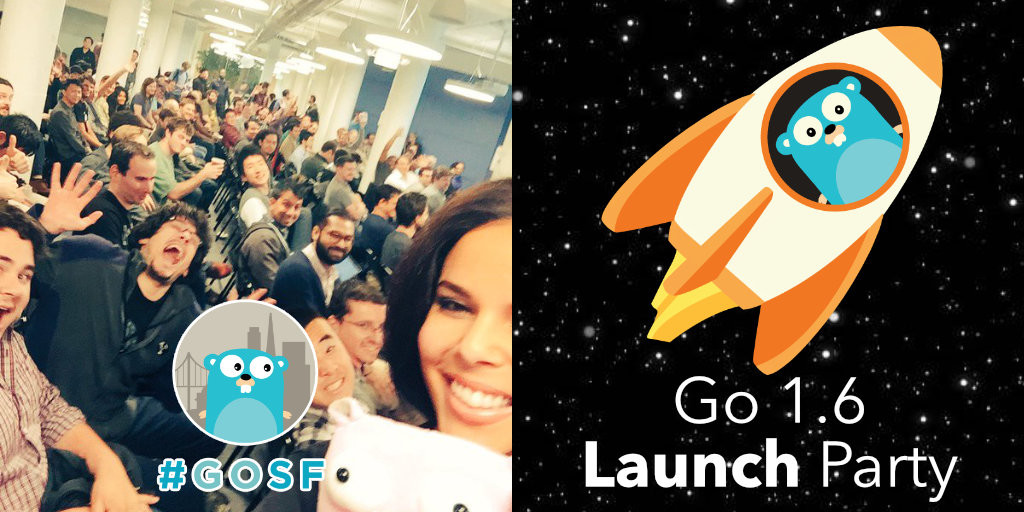GoSF: The 1.6 Release Party at Docker HQ
Lightning, thunder, and even hail swept through SF yesterday. But, that didn’t deter hundreds from hustling to Docker’s HQ for the Go 1.6 release party! GoSF received over 470 signups, a nice sum for a relatively young language.
Yesterday's launch party boasted trivia, stuffed gopher giveaways, and a limited run T-shirt from Iron.io’s Bruce Lu. Oh, and as always there were some great talks.
Video of the talks will also be online soon! For the impatient, we’ve also included summaries and slides of last night’s talks below.
The Growth of Go
Travis Reeder is the CTO at Iron.io. He kicked things off with a sentimental look back at Iron.io's history with the language.
Four years ago few companies were using Go in production. No surprise considering Iron.io took the leap before Go 1.0 released. Travis noted during that time it seemed like just Iron.io and Google were using it. Today Go is exceptionally popular. It’s used by companies GoPro, Segment, Heroku, and many others in production.
Go’s popularity is still rising. It's easy to see when comparing search interest for various programming languages. Travis shared charts showing that Go has already surged ahead of Ruby, Node.JS, C++, and others. One of the only languages that outpaces Go is Java; Which, is currently trending down as Go continues to move up.
To get more of the story (and view some snazzy charts!) check out Travis’ slides by clicking below:
The State of Go (All About Go 1.6)
Francesc Campoy Flores is a gopher at Google, and used his stage time to present a state of the union golang address. If you’re a regular on HackerNews, you might recognize some of this. These slides also popped up there 2 weeks ago.
Francesc’s presentation centered on the fun new goodies rolling out with 1.6. This includes new text/html templating, the welcoming of http/2 to net/http, and improved sorting!
The new sorting algorithm boasts a 10% improvement, but that’s nothing compared to the advanced made in the 1.6 garbage collection. The following slide says it all:

To view the full set of slides, click the following to head to Francesc’s deck:
Docker + Go: Integration Testing
Aaron Lehmann is a developer at Docker. His presentation focused on the ways Docker goes about testing, well, Docker.
Paraphrasing Aaron, their approach is to write Bash-like code in Go. But, why Go? Docker is written in Go, so it’s much easier to convince developers to contribute to tests when they’re using the same language.
You might be thinking, how do they perform this wizardry? I’m certainly thinking it. Aaron notes that you can see for yourself. Much of their testing library is available as an open source project, in the form of golem.
Golem looks like a super easy vehicle for testing Docker images. Pretty handy, given Tech's recent love affair with containers.
If you’d like to hear more about Docker’s testing strategy, head to Aaron’s slides by clicking below:
Rulio: a Rules Engine in Go
Jamie Stephens is a hacker at Comcast's Silicon Valley Innovation Center. He took to the stage to talk about a snazzy rule system he and his team have developed: Rulio.
First, what is a rule system? It’s a system where you write rules, add `facts` that rules can use, and then send events for the rules to respond to. Rules may be indelible, or scheduled to run just once at a specified time.
What’s snazzy about this is the ability to deliver snappy results, while querying facts from both remote and local sources. Rulio is designed be dynamic, to run distributed at scale, or run at home on your Raspberry Pi.
Pretty cool, right? To find out more about Rulio check out their GitHub repo.
What's New in Go Crypto
Nick Sullivan is a Crypto Wiz and developer at CloudFlare. His talk rounded out the evening with an inspirational angle. Is it cool when your contributed code gets merged back into the master branch? Nick thinks it is, and I do too. CloudFlare's been fortunate enough to see many of their contributions make it into the crypto package.
CloudFlare provides a service that needs to be both trustworthy and fast, which made Go a natural fit. Since Go 1.0 CloudFlare has been hacking on many projects to increase speed, and ensure that trustworthiness.
Nick's talk covered the journey that many of their open source projects took, as mapped along the Go release timeline. He also explored the new interfaces `crypto.Signer` and `crypto.Decrypter` in Go 1.6!
Have you ever been curious about Go’s inline assembly feature? Then you’ll definitely want to head over to check out Nick’s slides. You can get to them by clicking below:
Sweet 16 * 10^-1
Thanks to Docker for hosting. Thanks to Iron.io for the food, T-shirts, beer and organization! Big shout out to Iron.io’s @Cassandraoid for killing it as an MC. We also owe Dave Cheney and team a big thanks. They’re responsible for coordinating the Go 1.6 launch parties all over the world.
Know someone you’d like us to get on stage? Have a project that you’d like to share with the Go community? Let us know!
We’ll see you at the next GoSF meetup.

